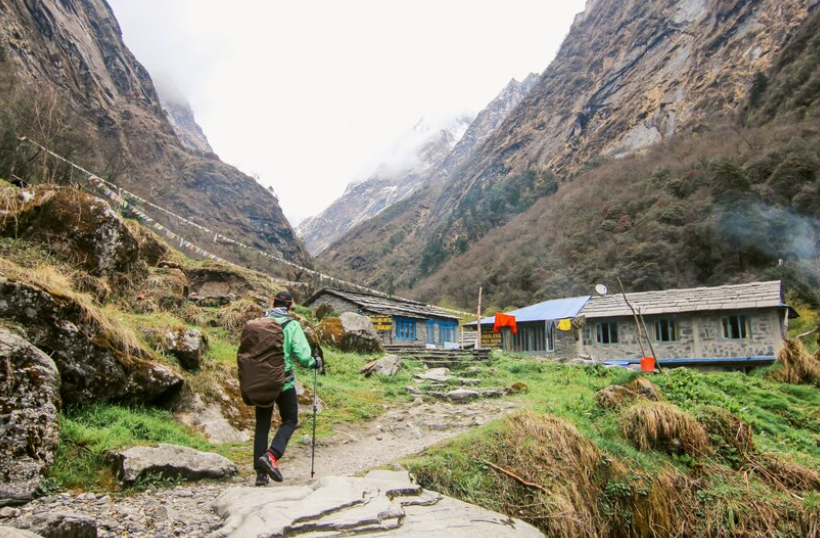
The Everest region, which boasts breathtaking scenery tucked away in the heart of the Himalayas and is primarily known for the Everest Base Camp Trek, attracts adventurers and nature lovers from all over the world.
With some of the world’s highest peaks, including the well-known Mount Everest, this region offers an unparalleled combination of spectacular scenery and challenging trekking opportunities. The Everest region, also known as the Khumbu region, is located in northeastern Nepal. Magnificent peaks, wide valleys, and old glaciers define the area’s breathtaking landscape.
Not only is this a hiker’s paradise, but it also serves as a sanctuary for a diverse range of flora and animals. As you descend into the lower elevations, you will see verdant rhododendron trees, quaint Sherpa towns, and terraced farms that seem to defy the elements.
Lukla is a medium-sized town in the Khumbu region of eastern Nepal, and the beginning point for nearly all Everest area treks.
At an elevation of approximately 2,860 meters (9,383 feet), Lukla is situated. This is an interesting place, deep in the Himalayas. Many hikers and mountaineers start their strenuous climb to the world’s highest peak from this location.
The area has now become a business endeavor due to the enormous number of trekkers, tourists, and mountaineers that visit Lukla every year. Because of this, the town is brimming with active trekkers who are on their way to Everest Base Camp, despite its small size.
Lukla is a popular tourist destination because of Nepal’s high-altitude airport. The small airport is perched on a mountain in the Himalayas of Nepal.
Elevation: 2,860 m (9,383 ft)
District: Solukhumbu
Area Code: 038
Province: 1 (Eastern).
Zone: Sagarmatha
Country: Nepal
Major attractions of Lukla
Lukla offers a few tourist attractions in addition to being well-known for being the beginning point of the Everest trek and expeditions. Some of the top attractions in Lukla are as follows:
Tenzing Hillary Airport
The airport is a well-liked attraction in and of itself because of its fascinating and challenging layout. It will be unusual to watch planes take off and land on the short runway.
The little airport known as Lukla was built in 1964 AD under the direction of Sir Edmund Hillary. Later, in January 2008, the airport was renamed Tenzing Hillary Airport in honor of Tenzing Norgay Sherpa and Sir Edmund Hillary, the first climbers of Mount Everest.
The Lukla terminal’s runway is composed of paved concrete that is comparatively short and narrow. At just 527 meters long and 65 feet wide, the runway at Lukla Airport is much narrower than those at similar airports.
There is no usage of aviation navigation or radar systems. During takeoffs and landings, radio communication is used instead. The small paved runway can only accommodate helicopters and small aircraft.
Because so many hikers visit the Everest region every year, the area is usually busy despite its small size. It marks the start of the popular EBC Trek Itinerary in Nepal.
Locals use airplanes to bring most building supplies and merchandise to Lukla and other towns and villages in the Everest region, in addition to transporting passengers.
Tenzing-Hillary Monuments
The Tenzing-Hillary Monument, a prominent landmark in Lukla, pays tribute to two legendary mountaineers: Sir Edmund Hillary of New Zealand and Tenzing Norgay, a Sherpa from Nepal.
The monument honors their amazing feats and the spirit of adventure that drives climbers to ascend the world’s most challenging summits.
It is a well-known location for travelers and trekkers who arrive in Lukla prior to beginning their journey because of its close proximity to the airport.
Tourists frequently stop to pay their respects, remembering the heritage of the pioneering climbers and the enduring spirit of human endeavor.
Gompas (Monasteries)
Though smaller in size, Lukla’s native gompas are no less beautiful. These monastic structures frequently have construction inspired by traditional Tibetan Buddhism and are adorned with colorful prayer flags that flutter in the alpine breeze. Exquisite artwork, antiques, and the sounds of prayer meetings with rhythmic chanting may all be heard within.
Lukla’s monasteries serve as centers for cultural preservation and host gatherings for the community in addition to being places of worship.
Religious festivals and ceremonies are eagerly observed, providing a window into the spiritual traditions and practices that have been passed down through the ages.
At these gompas, hikers beginning their journey to Everest Base Camp may find quiet time for reflection. Many choose to pause and absorb the serene atmosphere, which aids in their comprehension of the interconnectedness of the Sherpa people, their surroundings, and their spiritual beliefs.
These monasteries offer a distinctive experience that elevates travel in the Everest region by fusing cultural diversity with the grandeur of the natural world.
Local Markets
Lukla offers small markets where you may buy locally produced handicrafts, souvenirs, and traditional Sherpa items. There, you might find excellent mementos of your journey over the Himalayas.
Open for exploration are stalls showcasing a range of locally made goods, intricately woven fabrics, and traditional handicrafts made by the Sherpas.
The Lukla market offers a unique opportunity to purchase mementos that highlight the region’s rich culture and artistic talent, such as exquisitely carved handicrafts and hand-knit woolen goods.
Transportation to Lukla
The most popular route from Ramechhap or Kathmandu to Lukla is by air. Walking, which is a tedious and time-consuming activity, is an additional option, as is using the roads.
From Kathmandu to Lukla by flight
The flight fare for foreigners is approximately $217 USD, with no set pricing.
138 kilometers away
Time: 30 to 40 minutes
Well-known airlines include Tara Airlines, Summit Airlines, and Simrik Airlines.
Most passengers take the 30- to 40-minute flight from Kathmandu to Lukla. A number of planes take off daily when the weather is pleasant, either in the morning or during the day. But there’s no guarantee.
Weather patterns in Nepal are not always predictable, which might cause internal travel delays of one or two days. Additionally, for this trip, passengers are limited to checking in 10 kg of checked luggage and 5 kg of hand-carried luggage.
Make sure you properly pack your bag. There will be an extra $1 charged for each kilogram that you weigh above 10.
Ramechhap to Lukla Flight
133 kilometers separate Ramechhap from Kathmandu.
Four hours are needed to go from Kathmandu to Ramechhap (via local bus or vehicle).
The flight time from Ramechhap to Lukla is 20 minutes.
Additionally, airlines offer a flight from Ramechhap’s Manthali Airport to Lukla. By jeep or private vehicle, Manthali Airport is located around 133 kilometers (four to five hours’ travel time) from Kathmandu. Manthali is 20 minutes distant from Lukla, which is a stunning, picturesque flight.
Helicopter Flight to Lukla
An alternative method to get to Lukla is by helicopter. It takes around 45 minutes and offers views of massive glaciers, stunning landscapes, and wild animals.
Kathmandu to Lukla by Road
Traveling through various geographical features, the route from Kathmandu to Lukla offers breathtaking views of Nepal’s mountains, rivers, villages, rural areas, and customs.
It is not possible to drive directly to Lukla. First, we need to drive from Kathmandu to Jiri/Phaplu/Shivalaya/Bhandar/Salleri/Bupsa/Kharichola. It takes around a day to travel to these places from Kathmandu. After a few days of hiking from here, you can arrive in Lukla.
Best Seasons to Visit Lukla
Lukla Village has constant cold and precipitation. But there are also bright days there. The weather is normally clear in the early morning hours. But by late afternoon, fog has descended upon everything.
Here are a few of the ideal times of year to go to Lukla:
Springtime temperatures vary from 27.1°C to 17.4°C, with milder weather in the later months. With five to nine days of intense precipitation every month, rain is typically frequent in the later months.
Summer or Monsoon (June–August)
Tourists find the mid-year months uncomfortable due to the high temperatures. During the monsoon, Lukla receives a lot of rain and snowfall. There’s always going to be slick routes. This makes it the slowest season.
Hotels and other facilities are easily available in Lukla during the summer months when there aren’t as many hikers.
Some travelers pick June through August even though it rains during this time. It’s because it offers breathtaking vistas of the hills and mountains, as well as lush, glossy trees that have just had a wash.
Autumn or Fall (September–November)
The range of temperatures is 79.5°F (26.4°C) to 64.2°F (17.9°C). The weather is becoming better, and the days are bright.
The bright days can grow quite hot, even though the evenings are still cooler. As a result, it is among the busiest seasons in Lukla.
Winter (December-February)
The low temperature may be a challenge for those who enjoy warm weather. On average, there is very little precipitation (0–1 time each month).
There aren’t as many hotels that provide all the amenities you need for a great trip in comparison to other months. travelers as a result of the cold weather. There is, nevertheless, an excellent view of the surroundings and no barriers.
Lukla offers reduced accommodation and food prices in comparison to other seasons.
Accommodations in Lukla
There are many different places to stay in Lukla, including as high-end hotels, eateries, lodges, and teahouses.
Pricing may vary based on the facilities. Hotels provide all the amenities needed for a great trip. The interior design pays homage to the wonderful local culture and the welcoming host.
There are rooms with shared toilets and hot showers, and some without. Numerous of them have toilets in the Western manner.
Two single beds, a table, a hanger, a trash can, and charging ports are included in the guesthouse rooms’ amenities. The rooms have decently sized beds, pillows, and duvets that are reasonably warm. If needed, provide an extra blanket as well.
While hotel facilities differ based on the type of facility, they are all designed to provide visitors with a comfortable stay.
Nearly all of the hotels in Lukla have complimentary WiFi. In the event of a power outage, visitors can easily access the internet thanks to data packs. In this region, the NTC and Ncell networks are operating.
To purchase data packs, visitors must obtain a Nepali SIM card, which can be easily obtained in the local markets of Lukla, Pokhara, and Kathmandu.
Foods in Lukla
A vast array of food and drinks, including beer and traditional tea, hot lemon, hot juice, coffee, hot chocolate, and milk, are available at nearly every tea shop, hotel, and lodge in Lukla.
Most hotels include a large assortment of rice and noodle dishes. The combination consists of rice, a bowl of mixed vegetables, or a noodle dish with beef or chicken. Most of them also provide garlic soup, omelets, chapati, and pizzas topped with cheese and vegetables.
The most common breakfast items in Lukla include omelets, boiled eggs, chapati, oatmeal, fries, mashed potatoes, and porridge. Dinner and lunch are well-stocked.
On hikes, “Dal Bhat,” a traditional Nepalese cuisine, is served with boiling rice, lentils, cucumbers, and vegetable curry. It tastes well, is nourishing, and filling.
A range of healthful foods are also offered, including tomato sauce, fried rice, soups, potatoes, and both fried and soupy vegetable noodles. Desserts include rice pudding, chocolate cake, apple pie, and fruit drinks.
Conclusion
Adventure and spiritual exploration both have their origins in Lukla. It welcomes visitors with its renowned airport, rough terrain, and breathtaking vistas. It is the hub for climbing excursions and the starting point for the journey to Everest base camp.
Lukla hamlet offers a special fusion of natural beauty and cultural richness, symbolizing the meeting place of adventure and tradition.The hamlet welcomes everyone passing through to partake in its tapestry of experiences and create lasting memories of the Himalayan journey, whether one is training for an Everest climb or just enjoying the ambiance of this mountain town.







